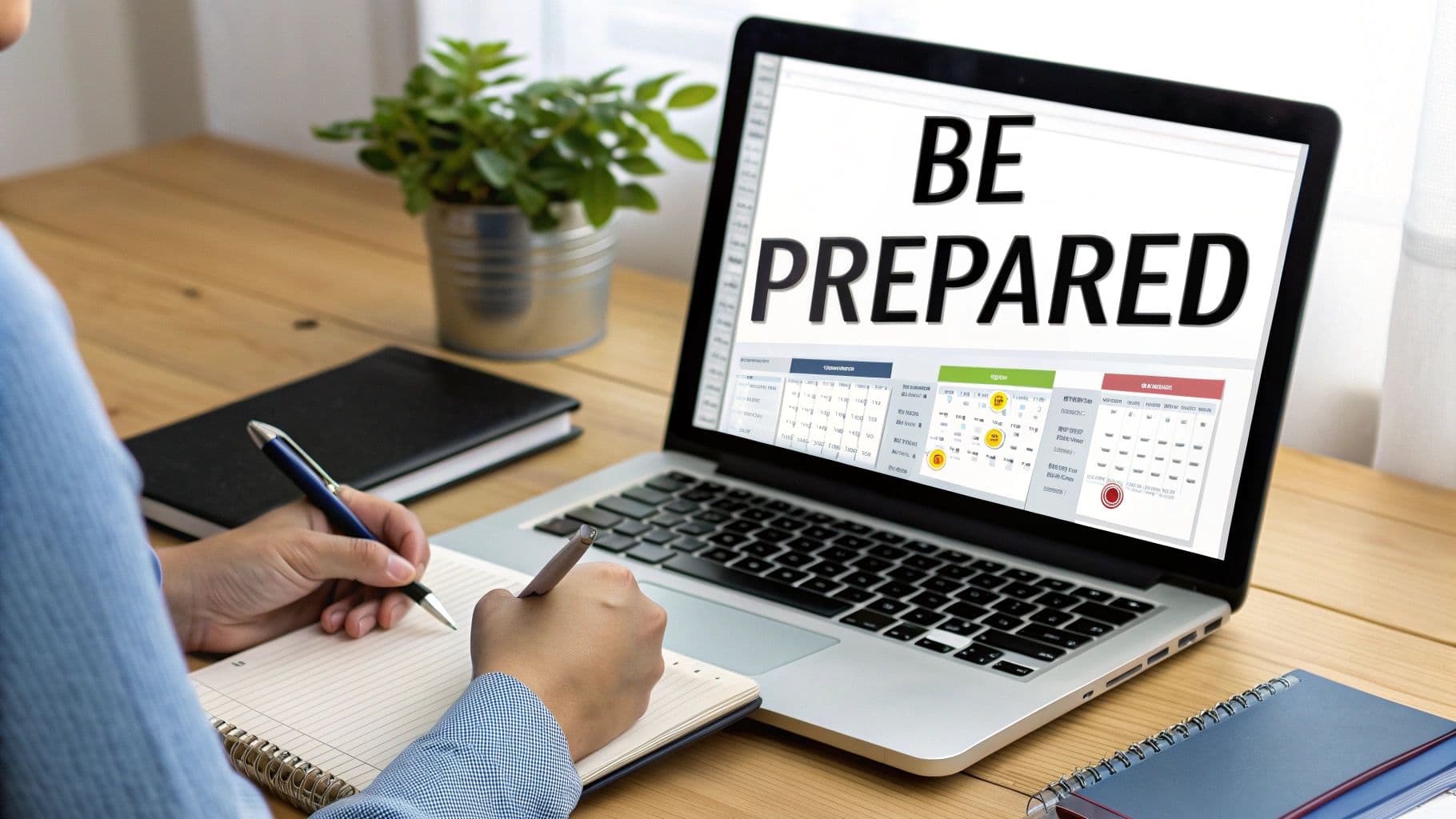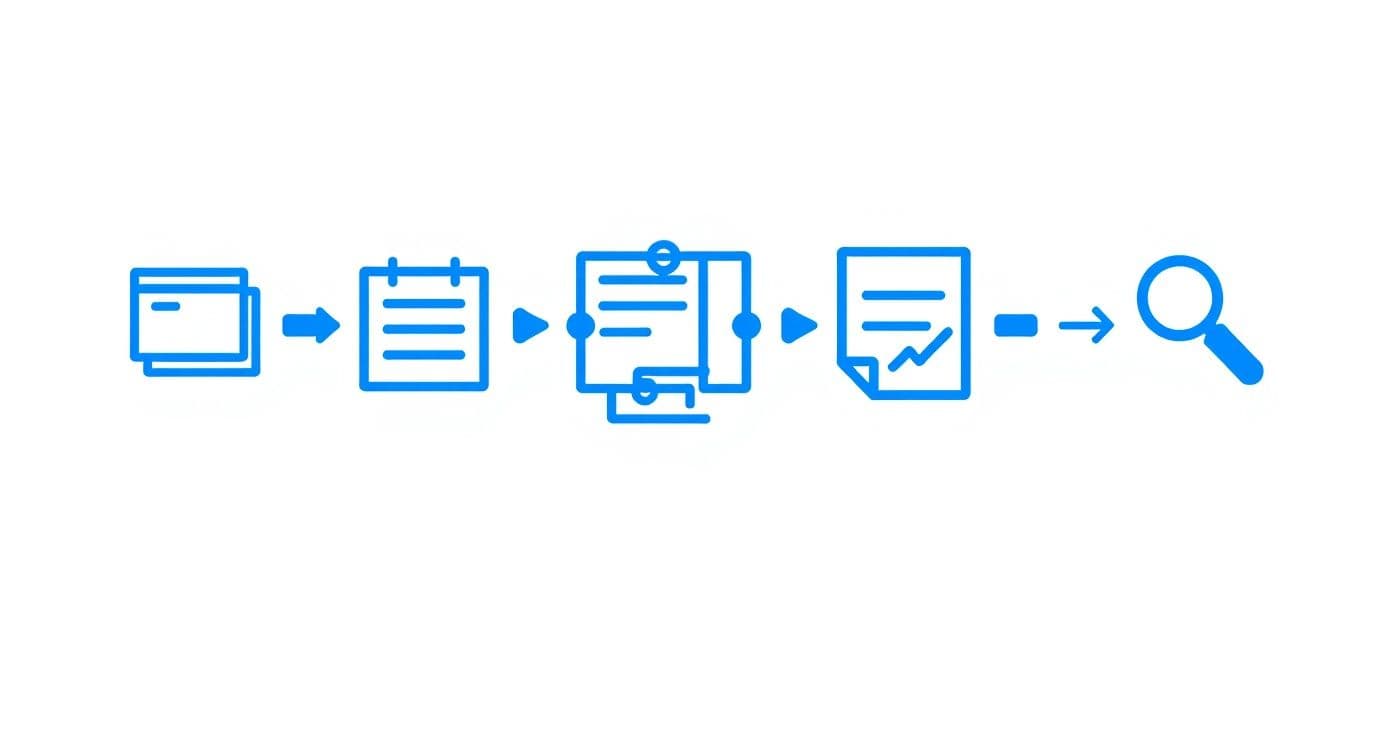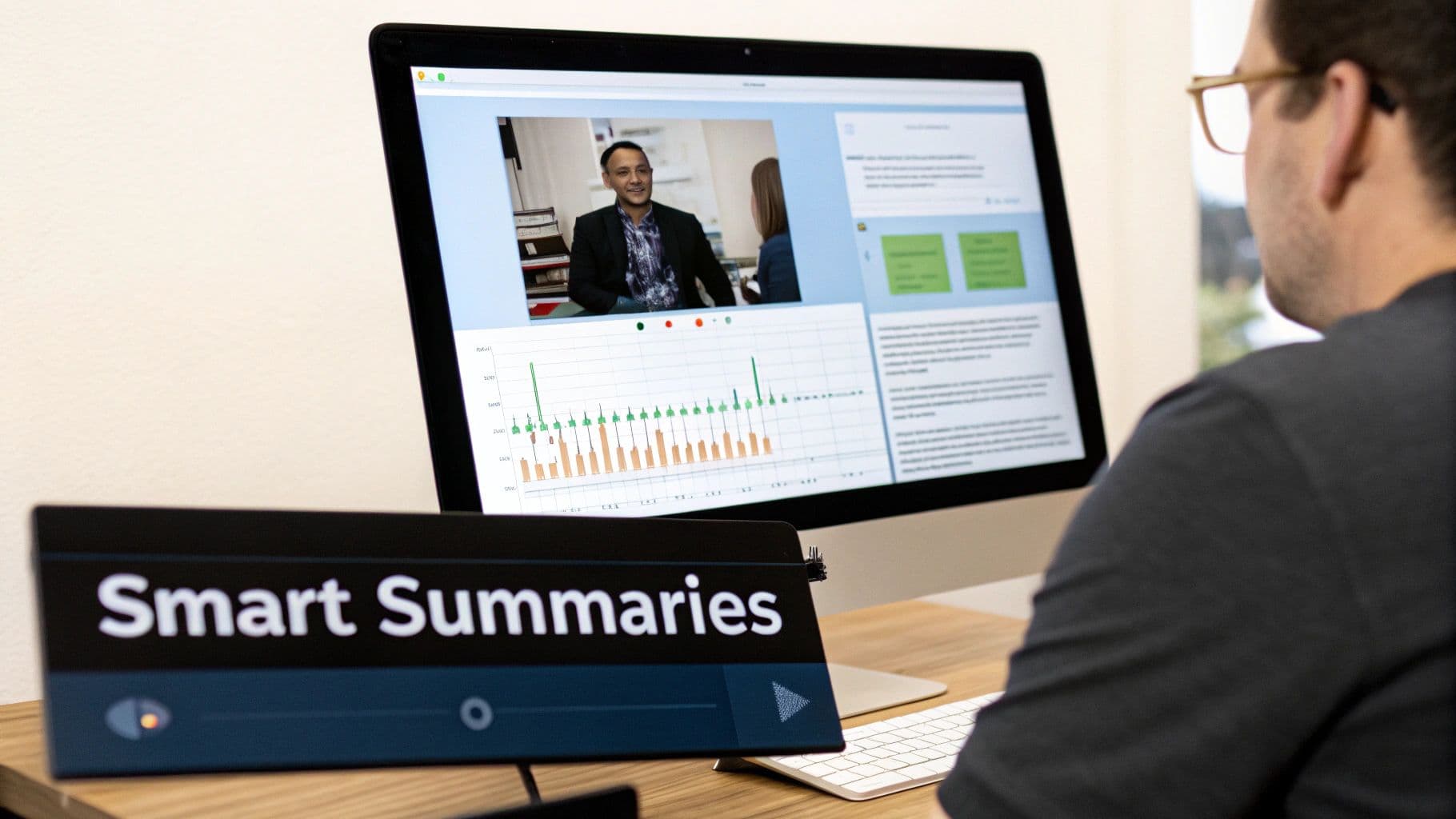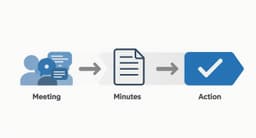Taking effective meeting minutes isn't just about recording what was said. It's about creating a clear, official record of the key discussions, decisions, and action items that came out of your time together. Think of it less as a word-for-word transcript and more as a strategic summary of what your team actually accomplished.
Prepare Before the Meeting Even Begins

The real secret to great meeting minutes has little to do with how fast you can type. The most important work happens long before anyone even joins the call. A bit of proactive preparation shifts your role from a passive note-taker to an active participant who can help guide the meeting toward tangible results.
This goes way beyond just a quick glance at the agenda. Before anything else, have a quick chat with the meeting organizer. Ask them one simple question: "What's the most important outcome you're hoping for from this meeting?" Knowing their main goal helps you tune your ears to what truly matters.
Set Up Your Template for Success
Once you’re clear on the meeting's purpose, get your note-taking document ready. Never, ever start with a blank page.
Use a template that already includes all the basic information: the meeting title, date, time, a list of everyone invited, and the main agenda items copied over. This saves you from scrambling to type names and topics while people are already talking. If you need a solid framework to start with, our guide on how to write a meeting agenda is a great resource.
If your team is spread out across the country or the globe, using a meeting planner for time zones is a small but critical step. It ensures all the scheduling details in your notes are accurate from the get-go.
To help you get started, here's a quick checklist you can use before every meeting.
Your Pre-Meeting Preparation Checklist
This table breaks down the essential steps to take before any meeting. Following it will help you capture effective and accurate minutes every time.
Having a solid plan makes all the difference. When you walk into the meeting with a structured document, you’re ready to capture what matters most.
Choose the Right Tools for the Job
The best tool for the job really depends on how your team works. For a collaborative session where others might add notes in real-time, a shared Google Doc can be perfect. For more formal meetings, you might prefer a dedicated app or a structured page in your company’s internal wiki.
With virtual meetings jumping from 48% of all meetings in 2020 to a staggering 77% in 2022, clear digital minutes have become absolutely essential. Your remote colleagues rely on these records to stay in the loop. By picking and prepping your tool ahead of time, you’re setting yourself up to document progress, not just conversation, the second the meeting kicks off.
How to Capture What Really Matters in Real-Time

Once the meeting kicks off, your job isn't to be a court reporter. If you try to write down every single word, you'll drown in details and completely miss the big picture. The real skill is active listening—tuning in to the specific things that move the project forward.
Think of it like being a journalist at a press conference. You're not there to describe the room's decor; you're there to pull out the headlines. For meetings, that means hunting for decisions, action items, and any major points of contention.
Zero in on Decisions and Action Items
These are the absolute must-haves for your notes. When you hear the team land on a final decision, get it down on paper immediately. This is the gold you're panning for.
The same goes for when someone agrees to do something. Don't just write "Jim will handle marketing." That's too vague. Nail it down with three critical pieces of information:
- The task: What exactly is Jim going to do? (e.g., "Draft Q3 social media calendar")
- The owner: Who is on the hook for it? (e.g., "Jim")
- The deadline: When will it be done? (e.g., "End of day Friday")
This simple "what, who, when" formula is what transforms a casual chat into accountable progress. It's the entire point of good meeting minutes.
Create Your Own Shorthand
You don't need formal stenography skills to keep up with a fast-moving conversation. Just come up with a simple shorthand system that works for you and stick with it. Consistency is key.
A game-changer for me was using simple tags to organize my notes as I go. It’s like using a highlighter, but way more efficient. Here are a few I rely on:
- #decision: For any final agreement or path forward.
- #action: For any task that needs to be done.
- @name: To quickly see who is responsible for an action item.
- #idea: For a cool thought or brainstorming point that isn't a commitment yet.
Using tags makes drafting the formal minutes a breeze later. You can just scan for your hashtags and pull out the important stuff without having to reread everything. This kind of clarity is more important than ever. In fact, 63% of us are seeing more people in our meetings these days, making a clean, scannable record essential for keeping everyone on the same page. You can read more about how meeting dynamics are changing.
And when the discussion gets a little heated or veers off track? Don't get pulled into documenting the play-by-play. Just make a quick note of the core disagreement or that the topic was parked for another time. Your role is to capture the outcomes, not the drama. Focus on this, and your minutes will become the tool that actually gets things done.
Structuring Your Notes for Action and Clarity
Once the meeting wraps up, your work isn't quite done. Think of your real-time notes as the rough draft—all the essential information is there, but it needs to be organized and polished. The real goal is to turn your shorthand and scattered thoughts into a clear, professional summary that makes sense to everyone, even those who couldn't attend.
This structure is what turns a conversation into forward motion. A recent report found that 50% of employees feel meetings are the biggest time-waster at work, usually because there's no clear follow-up. Well-structured minutes are the direct solution, providing the blueprint for what happens next.
Your final document isn’t a transcript; it’s a highlight reel focused on outcomes. Keep it scannable, concise, and geared toward action.
The Essential Building Blocks of Great Minutes
Every set of meeting minutes, no matter how formal or informal, should include a few core components. These elements create consistency and give busy team members a quick way to get up to speed.
- Header Information: Get the basics down right at the top. This includes the meeting title, date, time, and location (or virtual meeting link). It's simple but essential for good record-keeping.
- Attendees and Absences: Make a quick list of who was there and who couldn't make it. This provides crucial context for the decisions that were made.
- Decisions Made: This is the heart of your minutes. For each agenda item, write a clear, simple sentence that summarizes the final decision. Skip the long back-and-forth debate and just stick to the outcome.
- Action Items: This is what makes your minutes a productivity tool instead of just a historical record. A simple table here works wonders to make sure these tasks stand out.
The level of detail and formality will naturally change depending on the meeting. A quick weekly team sync won't need the same rigid structure as a formal board meeting, which often has specific legal documentation requirements.
Below is a quick comparison to help you gauge the right approach for different scenarios.
Template Comparison for Different Meeting Types
This table offers a comparative look at the structure and key elements required for minutes in different meeting contexts.
As you can see, one size doesn't fit all. The key is to match the structure of your minutes to the meeting's purpose.
The Action Item Table Is Your Secret Weapon
If there's one part of your minutes to obsess over, it’s the action item table. This is where accountability is born. I always recommend placing it right at the top of the document, just after the brief summary, so it’s the first thing people see.
An effective action item table only needs three columns:
This simple grid leaves no room for confusion. Everyone knows exactly what they’re responsible for and when it needs to be done. For more tips on this, our guide on a better meeting minutes format with action items goes into even more detail.
Finally, always give your minutes a quick proofread before you hit "send." A quick scan can catch typos or awkward phrasing, ensuring your summary is professional and easy to digest. It’s a small step that shows you respect your colleagues' time.
Your Post-Meeting Workflow for Real Results
So, the meeting’s over. You can breathe a sigh of relief, but the real work of meeting minutes is just getting started. Your raw notes are just the beginning; they don't become useful until they're polished, shared, and most importantly, acted upon. This post-meeting process is what separates a simple record from a powerful tool that actually drives progress.
The golden rule here is to move fast. Don't let your notes get stale. I always aim to review, edit, and send them out within 24 hours. When the discussion is still fresh in everyone’s mind, it’s much easier to fill in gaps, clarify points, and get quick feedback.
Finalizing and Distributing the Minutes
Before hitting "send," take a little time to turn your messy notes into a clean, professional document. This is where you translate your shorthand, fix any typos, and make sure every action item is unbelievably clear. Who is doing what, and by when?
Once it looks good, I always send the draft to the meeting chair or whoever ran the show. A quick once-over from them ensures you've captured the key decisions and outcomes accurately before it goes out to the whole team. It’s a small step that builds a lot of trust and heads off any potential confusion.
This workflow visualizes how you get from rough draft to final review.

As you can see, it's a cycle. You refine your initial notes, structure them, get them reviewed, and then they're ready to spark action.
When you're ready to share, pick the right spot for your team. Maybe it's a shared Google Drive folder, a task in Asana, or a dedicated Slack channel. The goal is simple: put the minutes where everyone can easily find them.
Turning Minutes into Action
Here’s where the rubber meets the road. The true power of your minutes is locked inside the action items. A list of tasks buried in an email or a document is easy to ignore. To get things done, those tasks need to live inside your team's daily workflow.
A great post-meeting routine involves more than just sending a summary; it requires assigning and tracking tasks effectively to hold people accountable. This is how you close the gap between talking about work and actually doing it.
Consider setting up automated reminders for due dates. This simple follow-up keeps tasks from falling through the cracks and shows that the minutes aren't just for show. When you build a system that tracks these commitments, you guarantee that every meeting actually moves the needle.
Using AI for Smarter Meeting Documentation

Let's be honest: taking meeting minutes manually feels like a constant battle between actively listening and frantically typing. You're always afraid you'll miss a key detail. Thankfully, technology now offers a much better way to handle this. AI-powered tools are built to do the heavy lifting, freeing you up to actually participate in the conversation.
Think of these tools as an AI assistant that joins your virtual meetings. It sits quietly in the background, creating a full, word-for-word transcript of the entire discussion. This transcript is the raw material for creating truly effective meeting records.
From Transcription to Actionable Insights
Modern AI tools have moved far beyond simple transcription. They automatically detect who is speaking, which immediately adds critical context to the notes. And once the meeting wraps up, the real magic happens. The AI generates a concise summary, pulling out what it deems the most important topics, key decisions, and next steps.
This kind of tech is becoming essential as our meetings get shorter and more frequent. In fact, a whopping 94% of meetings now last an hour or less, a shift made possible by tools that make recording and summarizing so much easier. You can dig into more current meeting trends to see how things have changed.
Choosing and Using AI Tools Wisely
As helpful as these tools are, they aren't foolproof. You have to go in with your eyes open and understand their limitations.
- Accuracy: AI transcription can sometimes get tripped up by strong accents, industry jargon, or when people talk over each other. It’s always a good idea to give the final transcript a quick human proofread.
- Privacy and Security: Before you let an AI tool into your meeting, double-check that it meets your company’s data privacy standards. And always, always be transparent with attendees that the session is being recorded.
- Context: An AI is great at spotting keywords, but it can miss the subtle nuances, inside jokes, or unspoken agreements that happen in a conversation. That’s where the human touch remains irreplaceable.
These AI assistants don't make the human note-taker obsolete; they supercharge their abilities. By taking over the tedious task of transcription, they let you focus on what really matters: capturing the meeting's true meaning.
If you're ready to explore this further, our complete guide to automated meeting transcription is a great next step. This approach is all about creating faster, more accurate meeting records with way less manual effort.
Answering the Tough Questions About Meeting Minutes
Even with the perfect template and a solid plan, taking meeting minutes in the real world can get messy. You're bound to run into some tricky situations. Let's tackle some of the most common questions that pop up once the meeting actually starts.
What if the Meeting Goes Completely Off-Topic?
It happens to the best of us. The agenda is all about the Q3 marketing budget, but 15 minutes in, everyone's debating the merits of the new coffee machine.
Your role isn't to be the conversation police. Your job is to accurately document what happened. Just make a brief note that the discussion shifted. Something simple like, "Q3 budget discussion was paused to address office facilities concerns," works perfectly. It shows what actually occurred without dragging everyone through the weeds of an irrelevant conversation.
How Detailed Should My Notes Be?
This is the age-old question: am I a court reporter or a journalist? For 99% of meetings, the answer is a journalist. Unless you're in a formal board meeting with strict legal requirements, no one wants or needs a word-for-word transcript.


